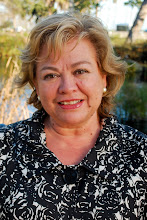
Serving Others Is a Way of Life for Goleta Couple
By Silvia Uribe
The story of Don and Judy Nason is an amazing one. It is the story of a lifetime focused not only on themselves and their family, but also on those who live around them. From keeping Goleta clean to guiding youth, they devote themselves to whatever needs to be done.
Their story together started almost 48 years ago, when they got married-or a couple of years before if we include the long-distance courtship. "Don wrote beautiful letters that often included a poem," remembers Judy with a warm smile on her face. For 16 years they lived in Australia, where they raised their two sons, Paul and Glen. In 1989, Don and Judy decided to come to California to spend more time with their aging parents, ending up in Goleta. A good job opportunity took them away to Texas briefly but they came back in 1997.
"We loved this city since the beginning," said Judy. "Although Don was new to the area I wasn't. I am a Westmont graduate, so I felt at home around here. It is so beautiful!"
Don is an engineer, with a degree in physics, and works part-time for Raytheon. Judy is a retired special education teacher. Both started volunteering at church, Judy as a teenager, and Don in his twenties, as a youth leader. He has worked with youth at risk ever since. "Youth was my first, and is my continued, draw to volunteering," he said. They never ceased their volunteer activities, even when raising a family.
"Most people have the time to volunteer, even if they have children," Don observed. "They just choose to do something else."
"When our children were little, Don would take some children from church on backpack trips, while I would fix the food for all of them to take on the trip," Judy said. "When our own children were old enough to go on those trips, the whole family went."
I asked Don about the most challenging volunteer work he's had. "The first one was a Coffee House in Australia where the 'roughest' juveniles hung out. You needed to be prepared for when arguments ensued, or when they wanted to harm each other. You needed to keep your cool and know how to react. But I think that even more challenging was when Judy and I were counselors-in-training for a crisis hotline. Calls came in for a variety of situations, from people needing a simple referral to an imminent suicide. Other than thinking on your feet and be prepared for whatever people threw at you, it was challenging because I took the night shift and still had to work the next day."
I was curious about why he took that shift. His answer was simple: "Because it was needed."
Locally, Judy has been a very active volunteer: Reading for the Blind and Dyslexic center, tutoring, working with a singing group of seniors at Vista del Monte, and leading church activities. Don has worked with juveniles in the court system through CASA (Court Appointed Special Advocates), and with the AVP (Alternative to Violence Project) in the California Adult State Prisons doing workshops for inmates: teaching them non-violent communication, self respect, and valuing others. "Inmates are very interesting people," Judy said. "They are experts, for instance, on how to deal with stress. I learn from them too!
"I've been an insider in the women's groups, a co-participant," she added. "They're likable people and I feel safe among them. They're not there to harm anyone. They're hungry for whatever you're going to teach them."
The Nasons don't care about how humble a job may be. If it is needed, they'll do it. An example of this is their Goleta Roadside Cleanup Program:
"I was on my way home one day when I observed all the trash that people throw on the streets," Don said. "I decided to do something about it." With trash grabbers donated by Goleta Beautiful, and volunteers from Dos Pueblos High School and their own church, the Cambridge Drive Community Church, the Nasons help keep Goleta clean.
"The most exciting thing we've ever found was a check for $10,000 that was a graduation gift for someone. I took it to the Goleta police station."
Their projects go across the board and across state borders. "Between the two of us, we have made six trips to other states to volunteer," Judy said. "The most recent trip was to New Orleans to help with the Katrina cleanup and rebuild efforts. We go where we're needed to do what's needed."
I asked what motivated them to do all this work for others.
"Many things," said Judy. "Jesus Christ is the person we admire the most. He always served others and never shied away from challenges. Also, we do it because giving is way more satisfying than receiving. We enjoy using our abilities, and we've had more than our share of blessings. We have plenty to give! Serving," she said, "is a natural part of life."
There are more than 500 nonprofit organizations in our area that need you: Volunteer!
Silvia Uribe is a freelance writer with a Latina perspective.
Cross-posted at the Independent.com






